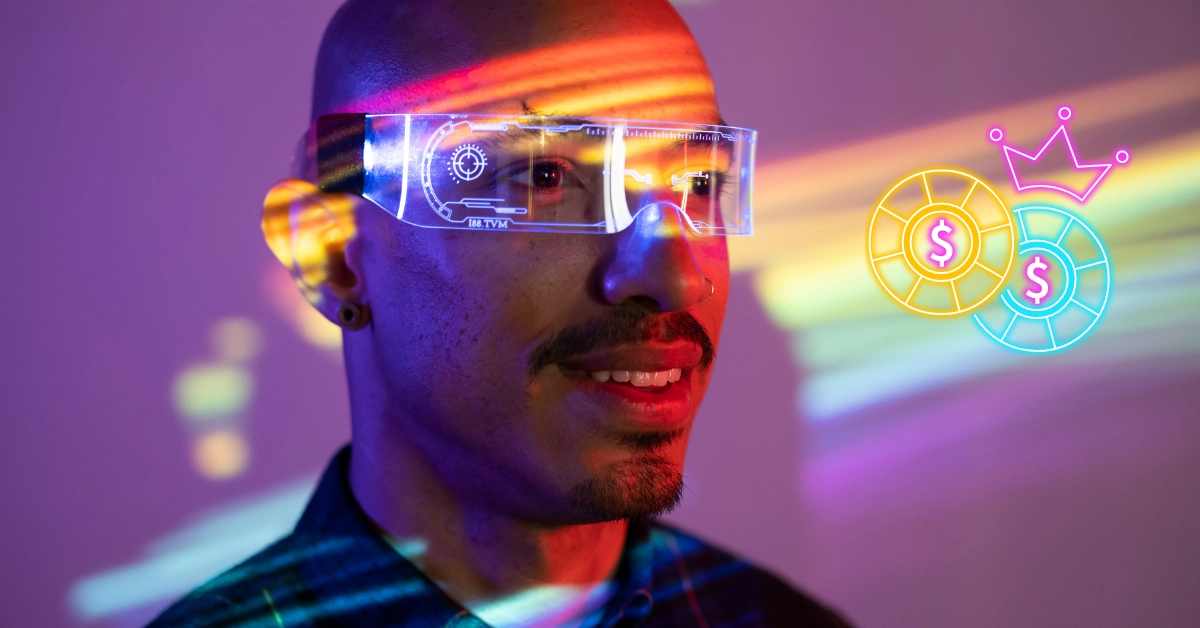The Role of Augmented Reality in Future Casino Apps

It’s Saturday night, and you’re chilling on your couch. You feel like doing something fun, but you’ve already watched all of the new movies and shows, but you don’t feel like going out.
What if you could turn your space into a casino? No, we aren’t pulling your legs. With augmented reality (AR) and a casino app, you could be surrounded by the sights and sounds of a casino. Your coffee table could be a roulette wheel; your bookshelf could be the backdrop for a poker game, and the slot machines? They could be projected right there onto your TV. You don’t have to walk out your front door or do something drastic like search Expedia for the cheapest flight to Las Vegas—the casino could come right to you!
AR is going from a far-off, interesting concept to a real part of our digital lives. And the casino apps you love to frequent? They’re up next to integrate with this tech. We could soon see our favorite games like poker, roulette, and baccarat being projected onto the surfaces in our homes. Amazing, right?
How is this possible? With AR, of course! And it could totally change how we play on casino apps. We’re going to find out exactly how AR could transform the way we play, what the benefits would be, and the challenges that might come with a new way to gamble!
What Is Augmented Reality (AR)?
When we talk about Augmented Reality (AR), we’re talking about the tech that adds digital elements to the world we see around us. Unlike virtual reality (VR), which creates a totally digital environment that replaces the real world, AR boosts your surroundings by overlaying images, sounds, or other digital content onto what you can see through a smartphone, tablet, or AR glasses!
Definition of AR
AR is basically the technology that mixes the physical and digital worlds, and it works by using a device’s camera and sensors to detect the environment and then placing digital content—like images, videos, or 3D models—into that space. This digital overlay interacts with the real world in real time! As an example, AR could transform your dining room table into a live battlefield for little soldiers in a mobile game or let you try on a new pair of glasses or makeup without having to go to the store; you can do it from wherever, as long as you have a compatible device.
AR vs. VR
It’s not hard to mix up AR and VR (virtual reality) because not only do they look alike and use computer-generated content, but they’re actually super different in how they engage with a user. Here’s the main difference: VR totally immerses you in a digital world, cutting you off from your IRL surroundings via VR goggles or a headset, but with AR, you’re still grounded in the real world—it’s just adding digital layers on top of that world. AR is just boosting your current reality and not replacing it.
AR in Popular Apps
AR has already found its way into some of the most popular apps that we use, including (but not limited to) the following:
- Pokémon Go – Pokémon Go uses AR to bring those adorable Pokémon into the real world by showing them on your phone’s screen as if they were actually there in front of you. Players physically move to different locations to catch Pokémon and interact with the game. The game was a global sensation and showed the potential of AR to mix physical activity with digital entertainment.
- Snapchat – Snapchat’s AR filters and lenses let users change their appearance and add fun elements like dog ears (the most iconic filter) and tons of others to their selfies and stories. The filters use facial recognition to remain in sync with the user’s movements. The AR features on Snapchat increased user engagement and set a trend for AR effects on social media platforms, as Instagram and TikTok followed suit.
- Google Maps Live View – Google Maps has an AR feature called “Live View” that overlays arrows and directions on your surroundings, guiding you to your destination as you walk, which makes navigating on foot in unfamiliar areas way simpler, showing real-world views with digital guidance.
- IKEA Place – IKEA Place was a boon—it allowed users to see how furniture would look in their homes by projecting 3D models of products into their living space through their phones. This app made furniture shopping less of a hassle by helping out with how the items will fit and look IRL. Other furniture brands, like Houzz and Amazon, now utilize this, too!

- YouCam Makeup – YouCam Makeup was the first to let users try on makeup virtually. From foundation to lipstick, you could experiment with different looks without physically applying anything to your face! Sephora, Ulta, and Charlotte Tilbury (there are a lot of others as well) have also integrated AR into their apps. This is a lifesaver for beauty lovers who don’t want to waste money buying products that don’t suit them.
- Quiver – Quiver brings children’s coloring pages to life in 3D. After coloring, kids can see their creations animated and interactive using the Quiver app—it merges regular creativity with modern technology, making coloring much more fun for the kiddos.
- InkHunter – InkHunter uses AR so users can see how a tattoo design will look on their skin before getting it inked, which is forever (unless you have the money to get it lasered off). Users are able to upload their designs or choose from the app’s library and see the tattoo on their chosen body part. InkHunter lessens the risk of tattoo regret by giving a preview of what it will look like before it becomes a permanent part of you.
- Google Lens – Google Lens levels up your phone’s camera with AR so you can identify objects, translate text, and learn about landmarks just by pointing your phone at them, which makes it simple to interact with and learn about the world around you with instant info and context.
How AR Could Change the Casino App Experience
You could turn your living space into an interactive casino where the games come to life around you! Augmented reality is on the cusp of changing how we experience casino games—it could make them a part of our everyday environments in ways that conventional online gaming can’t compete with.
Immersive Game Environments
Online casino games are great, but they are missing the atmosphere that brings people to physical casinos. AR could change this by bringing the casino experience right into your own environment. You are sitting in your living space, but instead of just using a device, you’re surrounded by a virtual poker table with a dealer and other players. The cards, chips, and the sounds of a busy casino floor would be there, making the experience so much more immersive!
Slot machines could also appear in your space, with the flashing lights, spinning reels, and sounds you’d find in a real casino—sounds fun and convenient, right?
Real-Time Social Interaction
A big part of what makes casino gaming so fun is the social interaction—talking to other players, swapping strategies and stories, and high-fiving wins. AR can bring that social aspect back into online gaming by letting you interact with others as if they were right there with you.
There could be avatars of fellow players and dealers sitting around a virtual blackjack table in your living room, and you could have conversations and experience the game together, just like in a real casino! It would make online gaming more communal, restoring the sense of connection that’s usually missing in the digital game space.

Physical Interaction with Games
AR also means there can be physical interaction with game elements, so the experience is more tangible. Instead of merely tapping on a screen, you could physically pull the lever on a slot machine, roll dice in a craps game, or put your chips on a roulette table. Hands-on interaction does wonders for making the games feel real and engaging.
By incorporating AR, casino apps can give users a gaming experience that’s so much more immersive, social, and interactive.
AR Features Likely to Appear in Future Casino Apps
The integration of augmented reality into casino apps could totally change the way we experience online gaming. As AR technology gets better, it promises to bring a level of immersion and interaction that regular old online platforms just can’t compete with. Let’s take a gander at some of the AR features likely to make their way into casino apps!
- AR Casino Rooms – We think one of the most exciting developments AR could bring to casino apps is the concept of virtual casino rooms that you can actually walk through. Instead of just navigating a menu on your screen, your physical space could be changed into a full-fledged casino. You could be walking through your den and different casino games would appear before you—then you pick what you want to play, just like you would in a brick-and-mortar casino!
This type of immersive experience would not only make online gaming feel more like you’re actually at the casino—it could also bring a sense of adventure to your gameplay. - Customizable Environments – AR technology also opens up possibilities for personalizing your gaming environment in ways that were previously unimaginable. Future casino apps could let you pick from a variety of themes for your very own virtual casino. In the mood for the vibe of a Monte Carlo casino? Done. How about a futuristic setup or the nostalgic charm of a classic Las Vegas atmosphere? Done. AR means you can tailor the look and feel of your gaming space to suit your preferences. The feature would make the experience not only more fun but also personal, and you would have the ability to switch between different themes depending on your mood or the time of day.
- AR Slot Machines – We all know that slot machines are a staple in both physical and online casinos, but AR has the potential to take slot spinning to a whole new level. How? Well, you could be sitting on your favorite recliner and BAM! A slot machine appears right before your eyes. You could physically pull the lever, watch the reels spin, and hear the sounds of coins dropping—like the machine was actually in front of you. The interactivity augments a tactile element to the game so it feels real and exciting. The combo of visual, auditory, and physical interaction could make AR slot machines one of the most popular features in future casino apps, fusing the best of both physical and online gaming.
- Live Dealer AR Games – Live dealer games have already brought a sample of the real casino experience to online platforms, but AR could take this even further. With AR, you could have a live dealer right there in your room, dealing cards on your coffee table, or spinning a roulette wheel on your kitchen counter! This could make the experience of playing games like blackjack or roulette much more fun—you could interact with the dealer and other players as if they were physically present. The dealer’s movements, facial expressions, and even their voice could be integrated into your environment, creating a more immersive and social experience that feels like you’re sitting in a real casino.
- AR Mini-Games – In addition to the more traditional casino games, AR could also bring with it a variety of mini-games that add even more fun to the experience. You could be on a treasure hunt in your own surroundings to find hidden bonuses or an AR scratch card game where you can virtually “scratch” off the card to reveal prizes. Mini-games could break up the more intense moments of traditional casino gaming with a lighter and more interactive way to engage with the app. They could also serve as a way to reward players with bonuses or extra credits.
Benefits of AR in Casino Apps
As augmented reality (AR) edges slightly closer to mainstream use, it’s setting the stage for a whole new world of possibilities in casino apps. AR isn’t just another gimmick or fad—it could make online casinos so much more engaging, social, and even profitable. Below is how AR could change the online casino world for both the players and the operators.
Better User Engagement
Honestly, playing casino games on a flat screen can get a bit ho-hum after a while. We are not knocking casino apps, but with AR, a whole slew of possibilities are, well, possible! How crazy is it that you would be able to have a virtual poker table pop up right in your bedroom? You wouldn’t be tapping away at buttons; you’d be physically reaching out to move your chips, pick up your cards, and make your bets. AR makes it feel like you’re really there, surrounded by the sights and sounds of a busy casino, and it’s a level of engagement that will keep players interested with games that are so vivid and immersive that players will feel that they’re part of something special. And when games are more fun, people are more likely to stick around, check out different games, and play longer. It’s a win-win for everyone!
Improved Social Experience
Online casino games have come a long way, but one thing they’ve struggled with is getting that social buzz of a real casino—but AR could change that. You’d be in a virtual casino room where you can see and interact with other players as if they were sitting right next to you. And it’s not just a chat feature; it’s a legit social environment that mirrors the community of a real casino. When you can see the other players’ avatars, hear their voices, and watch their reactions, the game turns from a solitary activity into a shared one, and that’s bound to make online gaming a lot more fun and interactive.
Increased Revenue for Operators
Now, let’s talk about the bottom line—revenue. Yes, AR is a great add-on, but it’s also a potential goldmine for casino operators. Players will spend money on in-app purchases when games are engaging and interactive. If you’re having a ball playing poker with a group of people, you’re probably going to buy another round or be willing to pay for extra features! Plus, the novelty of AR will undoubtedly bring in new players who would be willing to pay to check out this experience. That means more money flowing into the app, which translates into AR being a smart investment for any casino operator looking to up their profits.
Attracting New Audiences
AR isn’t just about keeping existing players hooked; it’s also about attracting new ones. Today’s tech-savvy gamers are always on the lookout for the next big thing, and AR could be just the ticket to grab their attention. These players aren’t just looking for games—they want experiences that are innovative, immersive, and, above all, fun. AR casino apps have the potential to reach these new audiences, bringing in players who might not have been interested in traditional online casino games. By offering something fresh and exciting, these apps can expand their reach and appeal to a broader demographic, from seasoned gamers to curious newcomers.
Challenges of Implementing AR in Casino Apps
Bringing augmented reality (AR) into casino apps isn’t as simple as adding a new feature or two; it requires overcoming some pretty big technological challenges. The first hurdle lies in the hardware limitations associated with AR. Unlike standard mobile games, which can run on lots of different devices, AR applications demand the most advanced technology. To provide users with a seamless and immersive AR experience, devices have to be equipped with powerful processors, high-quality cameras, and sophisticated sensors that can accurately detect and respond to the user’s environment in real-time. The need for specialized hardware means that only users with the latest smartphones or AR glasses can fully access and play AR-enhanced casino games.
The limitation doesn’t just restrict the audience—it also poses a challenge for developers who want to reach a bigger market. Older smartphones, which make up a huge portion of the market, will lack the necessary processing power and sensor capabilities to handle the demands of AR. As a result, users with these devices would experience lag, poor graphics, or even the inability to run the app at all, causing frustration and probably negative reviews. A fragmented user base makes it hard for developers to build a universally accessible AR experience, so they’d have to either narrow their target audience or invest in optimizing the app for all kinds of devices, each with different capabilities.
Technology Barriers
The integration of AR into casino apps has some technological hurdles, as well:
- Hardware Limitations: AR experiences necessitate advanced hardware, like AR-enabled smartphones or specialized AR glasses. And not every potential user has access to these devices, which will restrict the audience for AR casino apps to those with the latest technology, thereby excluding a massive portion of the market. A lot of users still rely on older smartphones that lack the processing power, camera quality, and sensor technology needed to run AR applications well.
- Device Compatibility: Even within the realm of AR-capable devices, there is considerable variation in how well different models can handle the technology. High-end devices, like the latest iPhones or Samsung Galaxy models, would probably give users a seamless AR experience, but mid-range or older devices could struggle with some performance issues. The challenge for developers is to make sure that their AR casino apps work well across a broad spectrum of devices. This will take time and resources to test and optimize the app for each device, which adds complexity to the development process. And as AR technology continues to change, staying compatible with new devices while maintaining support for older ones will be an ongoing problem to tackle.
Data and Battery Consumption
AR’s immersive experiences come with a high demand for data and power, which brings us to the next hurdles:
- High Data Usage: AR applications need a constant data flow to deliver real-time interactions and high-quality graphics. The increased data consumption can be a deterrent for users who have limited mobile data plans or live in areas where data costs are high, and users may find themselves quickly depleting their data allowance, which would make them hesitant to play AR-enabled games, especially if they like extended gaming sessions.
- Battery Drain: Running AR applications is a power-intensive process. The continuous use of the device’s camera, sensors, and graphics processing units can rapidly drain the battery, which means shorter gaming sessions. And for users who are on the go, the battery drain can be a huge inconvenience, potentially discouraging them from using AR features. Developers are up against the challenge of optimizing AR apps to be more battery-efficient, but the inherent demands of AR technology mean that power consumption will likely remain a concern.
Cost of Development
Creating and rolling out AR features for casino apps goes way past coding—it’s actually a complicated process that takes a lot of investment!
- High Development Costs: Creating high-quality AR experiences necessitates so much more than how an ordinary, everyday app is made. It takes super-specialized skills in 3D modeling, real-time processing, and cross-platform optimization, all of which come at a premium price. For smaller developers, the cost of hiring the necessary talent and purchasing the right tools can be prohibitive. And then there is the need for extensive testing across various devices further, which drives up costs even higher. The sky-high barrier to entry will make it difficult for smaller companies to compete with larger, more established developers who have the resources to absorb the costs.
The Future of AR in Casino Apps
As augmented reality keeps moving forward, its integration into casino apps has the promise to be one of the most exciting advancements in online gaming since its inception. When AR is mixed with other emerging technologies like AI and 5G, the future of AR in casino apps looks like it is set to deliver a super immersive, intuitive, and connected gameplay. Below is a sneak peek at what the future might bring!
Integration with Other Technologies
The true potential of AR in casino apps will only be unlocked when it’s integrated with other cutting-edge technologies, such as the following:
- AI and AR: Artificial Intelligence (AI) could supercharge the AR experience in casino apps, as it can be used to create smarter, more intuitive gaming environments where virtual dealers react in real time and adapt to player behavior just like a human dealer would in a physical casino. An AI dealer would be able to learn from your playing style and adjust the game’s difficulty accordingly or give players personalized game recommendations based on their previous go-to games.
- 5G Connectivity: The rollout of 5G technology is another big factor that will level up AR in casino apps due to its promise of ultra-fast speeds and low latency. 5G would be able to reduce the lag that currently hampers real-time AR interactions, which translates into smoother, more seamless gameplay where players can interact with virtual environments and other players instantaneously without any annoying delays that can break immersion. As 5G networks become more common, they will likely play an important role in making AR-enhanced casino games more accessible and fun.
The Path to Mainstream Adoption
We love the idea of AR in casino apps and all of its possibilities, but there’s still a ways to go before it can become a standard feature. The pace of technological advancement and user adoption will largely determine how quickly this happens.
- Timeline for Adoption: Currently, AR is still in its early stages within the gaming sector. While it’s gaining traction, widespread adoption in casino apps is likely to take several years. The adoption curve is expected to follow the bigger trends that are seen with other technologies—initially slow as the early adopters lead the way, then followed by a more rapid uptake as the tech is more polished and accessible. Then, if players see the benefits of AR in gaming, the demand would grow, which would encourage more developers to incorporate AR features into their apps. The process could take anywhere from five to ten years—it all depends on the advancements in supporting technologies like AI and 5G, as well as improvements in the necessary hardware accessibility.
Predicted Market Growth
The future of AR in casino apps isn’t just concentrated on making games more fun (although that’s a big part of it); it’s also expected to bring with it serious market growth.
- Market Predictions: The global AR market is expected to see substantial growth over the next decade. By 2030, the AR market could reach upwards of $248 billion, with a big portion of this growth driven by the gaming sector. As AR starts to be integrated into gaming, the gambling sector is predicted to be a major beneficiary, with AR-enhanced casino apps at the front of the line. The growth will be driven by an increasing demand for immersive gaming experiences, the expansion of 5G networks, and ongoing investments in AR technology by major players like Google, Microsoft, and Apple.
- Implications for the Gambling Sector: As AR technology becomes more prevalent, it’s not only expected to transform how games are played, but also how they’re developed and marketed. Casino operators who adopt AR early on could gain a solid competitive advantage, attract a younger audience, and possibly increase player retention and spending. As the technology matures, AR could become a standard feature in premium casino apps and give players a more immersive and interactive experience than ever before!
Conclusion
AR technology is going to get better and better, and that means that casino apps will get a lot more interesting. The games you love to play won’t just be limited to your phone or tablet screen—they’ll jump out and be right in the room with you! But, and this is a big “but,” before AR becomes a part of online gambling, there are some bumps that need to be ironed out.
Ready for a recap? Look below for everything we touched on above:
AR technology could allow you to turn your living room into an immersive casino environment with virtual poker tables, slot machines, and more without leaving your home.
• AR elevates the real world by overlaying digital content onto physical spaces, unlike VR, which creates a completely separate digital environment.
• AR uses a device’s camera and sensors to blend digital elements with your real surroundings in real time.
• VR fully immerses users into a digital environment, basically cutting them off from the real world.
• AR boosts your current surroundings with digital layers, so it’s way more accessible for everyday use.
• Pokémon Go: Integrates digital Pokémon into the real world, encouraging physical movement and interaction.
• Snapchat: Uses AR filters to alter appearances or add digital effects to selfies.
• Google Maps Live View: Had real-time navigation with AR by overlaying directions onto the real world.
• IKEA Place: Users can place digital furniture in their home to see how it fits and looks.
• YouCam Makeup: Users can virtually try on makeup, helping them to make purchase decisions.
• InkHunter: Gives a preview of how tattoos will look on the skin before committing.
• Immersive Game Environments: AR can bring the casino experience into your home, so that it feels like you’re actually in a casino with virtual tables and slot machines.
• Real-Time Social Interaction: AR could enable more natural social interactions with other players in real time, making online gaming more communal.
• Physical Interaction with Games: AR means players can interact with virtual elements in a tactile way, like pulling a virtual lever on a slot machine.
• AR Casino Rooms: Virtual spaces where you can move around and choose games like you would in a brick-and-mortar casino.
• Customizable Environments: Options to personalize the look and feel of your virtual casino, from luxurious themes to futuristic setups.
• AR Slot Machines: Fully interactive, 3D slot machines that appear in your home and respond to your physical actions.
• Live Dealer AR Games: Virtual dealers that interact with you in real time, right in your living room.
• AR Mini-Games: Small interactive games within the app, like treasure hunts or scratch cards, that add extras to the gaming experience.
• Better User Engagement: AR’s immersive experiences keep players engaged for longer by making games more interactive and real.
• Improved Social Experience: AR brings back the social element of casinos by allowing players to interact as if they’re physically with one another.
• Increased Revenue for Operators: The improved experience could result in more in-app purchases and spending.
• Attracting New Audiences: AR is likely to bring in tech-savvy users who are looking for more innovation in gaming.
• Technology Barriers: AR needs super-advanced hardware and device compatibility, which might limit the user base to only those with newer technology.
• Data and Battery Consumption: AR apps eat up more data and battery, which could deter users from long gaming sessions.
• Cost of Development: High-quality AR experiences take a lot of monetary investment, so it will be harder for smaller developers to compete.
• Integration with Other Technologies: Combining AR with AI and 5G will make casino apps more personalized and responsive.
• The Path to Mainstream Adoption: Widespread adoption of AR in casino apps could take years, depending on how quickly the technology advances and becomes more accessible.
• Predicted Market Growth: The AR market, particularly in gaming, is expected to grow, with the gambling sector likely benefiting from the expansion.
Bringing AR tech into casino apps will def be an elevation of the games we love to play—it’ll make them more fun, more interactive, and way more social! But, we can’t put the cart before the horse—it won’t be an easy integration. There is fancy hardware needed, not to mention how much it will cost to develop, so they’ll have to figure that out before it happens.




